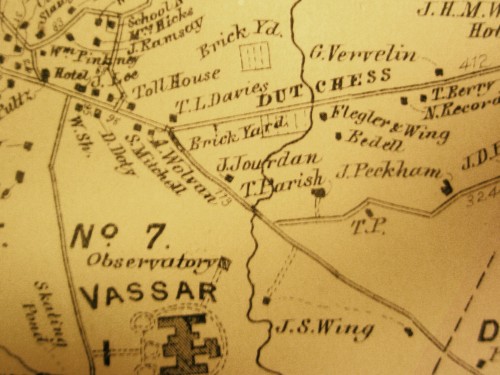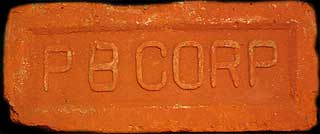The Rise and Fall of “Brickyard Hill”
June 3, 2010 by admin
-

- This 1867 map shows two brickyard sites to the west of the Casperkill
At the beginning of the 20th century, brickmaking was the dominant industry along the Hudson River. The extraordinary growth of New York City between 1880 and 1920 guaranteed a steady demand for Hudson Valley bricks, while the uniform clay banks running from Albany to Westchester supplied copious amounts of raw material for the industry. These conditions allowed for the emergence of numerous independent brickyards along the river, one of which resonates specifically with friends and residents of the Casperkill watershed.
In Poughkeepsie, the history of brickmaking goes hand in hand with the history of the Casperkill. Up until the 1790’s, the area currently known as Arlington was nothing but undeveloped marshland. The Casperkill flowed through it, undisturbed, before reaching the more urbanized areas of Poughkeepsie. But by the early 1800’s, a clay mine and brick manufacturing area had replaced the swamps, occupying what has come to be remembered as “Brickyard Hill”. The site, located where Manchester Road branches off from the Dutchess turnpike today, was then occupied by a farm called “Rogers Farm”, where Thomas Vassar, Matthew Vassar’s uncle, is believed to have worked making bricks as early as 1811. The Vassars had been brickmakers in England, and they continued to practice the trade in the U.S. with great success. Their business thrived as they supplied local needs and possibly even larger markets. One historian speculates they may have navigated the Casperkill down into the Hudson, thus accessing more lucrative markets downstream. But Thomas Vassar was only one of several brickmakers mining the site, who together produced as many as 4.5 million bricks a year. In 1833, “Rogers Farm” was purchased by Charles Vassar, Matthew Vassar’s brother, who leased it for the manufacture of stock bricks known as “Poughkeepsie Stretchers”. Business was steady for a while but, by 1843, competition from other brickyards with greater clay reserves along with a fall in local demand pushed Vassar into an economic crisis so that he was forced to sell the property. The “Rogers Farm” brickyard was operative for almost a century after that, changing hands frequently and eventually closing down in 1932.

- The Poughkeepsie Brick Corp. was the last yard to operate on Brickyard Hill
Almost a century and a half’s worth of clay mining left a gaping hole in the ground, which was soon after leased to the Town and City of Poughkeepsie to be used as a municipal landfill. Today, the area is occupied by the Dutchess and 44 Plaza shopping centers.
Sources:
Hutton, G.V.,2003. The Great Hudson River Brick Industry: Commemorating Three and Half Centuries of Brickmaking. Purple Mountain Press. Fleischmanns, New York,
Robins, Lucy, 2006. A Look into Past: A Land Use History of the Route 44 Plaza and the Casperkill Watershed, Vassar College.
Vassar College Environmental Research Institute, 2009. Health of the Casperkill, Dutchess County, New York.
Images:
Vassar College Special Collections
The Hudson River and New England Brick Collection and Identifier, available on http://brickcollecting.com/collection.htm#haight.